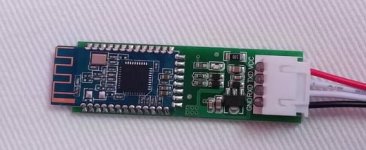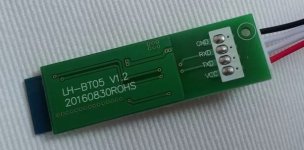cglass said:
ElectricGod said:
There's no access to the P- connection. Same for the 24S version. I'll have to get longer screws so that I can add copper on top of the mosfet tabs to add P-. Grrr! All you get at those solder tabs is B- and C-...what a waste. If you don't mod the BMS, you have to charge and discharge via C-...I'll pass! The copper reinforcing is done well, solders to each mosfet and over laps the wire bond pads.
I have the 24S version that I am almost ready to install... but after reading your post, I am considering adding P- first. Before I do, I would like to ask two fairly novice questions:
1) What is the benefit of separating P- from C-?
2) Is the modification simply a case of soldering a copper wire to the trace connecting the HY045N10 screw tabs (I am guessing this is the FET's drain since I have not had much luck finding the HY045N10 datasheet yet), reinforcing the trace with a copper strip, and linking this directly to the loads negative - as shown in the image below?
BMS_P-.jpg
Which is better? More resistance or less resistance? OK...not enough information, becasue both are correct in the right circumstance. In an EV, you want the maximum amount of voltage and current possible exiting the battery pack and making it to the motor and NOT getting lost/wasted in other places. This comprises a significant efficiency improvement or loss and can almost always be detected as heat. Heat is caused by the process of restricting current flow and therefore reduced electricity available to make you go.
a. The motor isn't a perfect conductor and has internal losses...heat is the result. You want to use a motor that is efficient so it wastes as little electricity as possible as heat.
b. The wires to and from the motor or controller, battery, BMS and elsewhere are not perfect conductors. Some electrical loss as heat happens in them. You want to use large wires that have very low resistance since they will lose some amount of electrical power as heat but less than other options.
c. The motor controller has mosfets. They may have higher or lower internal resistances. More resistance is always going to create more heat than less resistance in the mosfets. Mosfets always have some amount of resistance and it can't be helped. Use mosfets that have a very low Rds such as the AOT290 or CSD19536KCS and others so that you minimize heat losses due to mosfet resistances.
d. If you have interconnects between things, use connectors that are very low loss such as 5.5mm bullets.
Geez, that took forever to get around to answering your questions.
1. So then P- vs C-. In any BMS, you have 2 sets of mosfets. One set controls charging and the other discharging. You want mosfets in a BMS so that in the event of an over load or pack depletion event the BMS can protect your valuable batteries. However, there's no need for putting multiple sets of mosfets in series as this does not create extra safety, just extra losses. C- (charging) mosfets pass current through the P- (discharge) mosfets to get to the battery. No one cares about a little loss when plugged into the wall outlet, just when riding on batteries. Imagine if you are running your EV from C- and therefore through the 2 banks of mosfets. In series that's 2 sets of resistances that are generating heat. Now if you eliminated the C- mosfets, now your heat and electrical losses have also dropped in half. So then powering your EV from P- is more efficient than is powering it from C-. You can run your EV from C-, but it's less efficient.
Really BAD, crappy, awful mosfets would have an internal resistance of .1 ohm. Pathetic mosfets (HY3410) have an internal resistance of .04 ohms. Decent ones have an internal resistance of .004 ohms and really good ones like the CSD19536KCS have a resistance of .0025 ohms. Less resistance in the mosfets means less loss as heat. This is very much a game of less is more and waaaay less is waaay more. Regardless of whatever mosfets are in your BMS, the fewer of them in series creating resistance to current flow and heat losses the better!
2. Yes...you need copper (IMHO) under all those nuts on the same side as the other copper busses. Put the copper under every single one of those nuts that holds down a mosfet. Over lap it onto the P- solder pad. Solder it down to the P- tab. I wouldn't worry about soldering the copper down elsewhere. You have a zillion screws holding it firmly in place. It would be a good idea however to tin the entire copper strip so that it can't oxidize and then conduct less. Yes your picture is exactly how I would connect power to the EV.
I want to say one last thing...
You CAN use the BMS without the added copper. However resistance is losses and copper is a great conductor with minimal losses. The bare traces on the board can handle a considerable amount of current, but IMHO, they are not really adequate. If they were, why did the manufacturer beef up the other power traces? I think you see my point.
I'm a stickler for losses I can prevent...such as missing copper, crappy mosfets, under sized wires, cheap solder, low grade connectors, cheap bearings, low pressure tires, lossy chain drives, dragging brakes and so on. I don't even use a transmission or derailleurs becasue they add losses. It's my opinion that an EV should be all about the fun factor, efficiency and no pollution and making that happen for as long as possible. Losses as a general statement are BAD.












